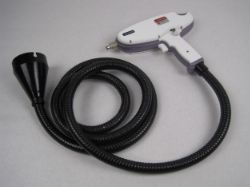I've sent Sam Goldwasser at the Laser FAQ a spreadsheet for calculating lamps.
I'd start with having him help you reverse engineer the xenon flashlamp parameters.
I'm up to my ears with projects right now, but Sam is retired.
For good Yag operation, one likes a higher voltage and smaller capacitor on a flashlamp pumped system like that. I used to service a similar product line used in labs, not for medical.
You need a cap charger, a cap, a series inductor of between 20-40 uH etc. You'll need a series injection trigger transformer, the whole lamp current flows through the trigger transformer. Due to the wet cavity, an external spark will not do.
If you can find a big Russian diode, you can also simmer and injection trigger the lamp. Coherent will have probably simmered the lamp, which is running a 30-60 mA current at DC through the lamp and dumping the cap into the lamp via a high DI/DT SCR or IGBT and a blocking diode..
However the classical external trigger will not work.
The good news is you can wind the inductor easily enough out of #10.
Coherent's Medical Partnership (Aka Lumenis) (and nearly every one else) flows partially deionized, filtered water through the cavity. Just a few litres per minute, at low rep rates like that. You need water at about 8 Megohms, not fully De-Ionized water. Fully deionized 18 Meg water will corrode the cavity. This is achieved by connecting a very small deionizer cartridge across the tubes to the laser head with tiny *********; sized tubing. The DI cart thus never sees enough flow to fully de-ionize the water. Without water, you run a strong chance of imploding the lamp.
The goal for running the small YAG laser is a critically damped flashlamp circuit. Otherwise you get horribly short lamp life. Running a mix of low voltage caps will not be such a good idea. The critically damped circuit gives you a higher peak power in the rod, which is desirable.
That has enough connectors on it that I believe it will have a Electro-Optic Q Switch on it.
SAM's page in the FAQ on the SSY-1 will give you a good start.
EG&G / Perkin Elmer have flashlamp guidebooks that are on the net at multiple locations.
You'll need to open the cavity up and see if there is a Q-switch crystal in there. May be, May not. Your pulse length spec is too vague for me to decide.
Pulse times in Nanoseconds indicate a Q-switched Laser. Pulse times in 100s of nanoseconds or a few microseconds indicate a free running laser.
YAG Pulse times in milliseconds mean the laser is probably Quasi-CW. Quasi CW means the lamp is simmered and a long DC pulse is dumped into the lamp for a few tens/hundreds of milliseconds using a switching power supply. (very rare)
50J/CM^2 at what spot size? That is not a 50 Joule head, by any means. (50 Joule per pulse Yags are massively huge)
READ:
http://www.google.com/url?sa=t&rct=...=mh0qiCHJondR2-WjH927wQ&bvm=bv.75097201,d.aWw
I've emailed my medical YAG friend, I'll see if he knows about that one.... It looks like a small IR "Versapulse" cavity.
Oh, and did I mention you need laser safety glasses of at least Optical Density 6 or OD7....
Lumenis reuses model names like crazy, you'll have a hard time finding data.
Steve





